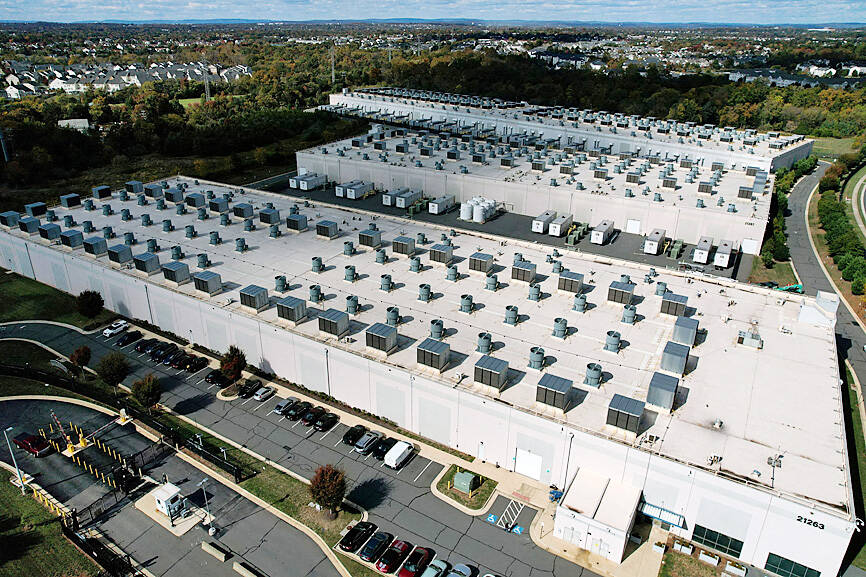Amazon.com Inc’s data center operation is much larger than commonly understood, totaling more than 900 facilities in more than 50 countries, documents reviewed by Bloomberg and investigative Web site SourceMaterial showed.
Amazon Web Services (AWS) is best known for sprawling data center hubs in Virginia and Oregon, but those enormous complexes, which the company owns or operates through long-term leases, do not account for its full footprint.
The cloud unit also stashes server racks in hundreds of so-called colocation facilities, renting space that as of last year provided about one-fifth of the computing power at Amazon’s disposal, the documents showed.

Photo: Reuters
Called “colos” in the industry, the rented data centers are typically sub-divided among different clients. The AWS presence in such facilities ranges from a few server racks in a dedicated room to most or all of enormous buildings in places such as Frankfurt and Tokyo, it showed.
AWS does not disclose the locations of individual data centers for security reasons and to keep operational details out of the hands of competitors.
The documents shine a light on Amazon’s cloud computing operations at a time when investors are keen for insights into whether AWS has sufficient capacity to meet the enormous computing demands for artificial intelligence (AI).
They also showed that AWS is one of the world’s largest renters of colo space, suggesting it has the flexibility to offer customers a range of services around the globe.
“There are big data centers everyone talks about, but the reality is there are also these smaller cloud resources that are invisible,” said Nic Benders, chief technical strategist at New Relic, which helps businesses manage their technology infrastructure. “The cloud providers do not like to tell you where they are.”
As of early last year, AWS was relying on more than 440 colocation data centers. The company also operated from more than 220 additional rented “edge” locations, which provide access points to Amazon’s network near major metropolitan areas, often inside telecommunications hubs operated by third parties. The company’s presence at some of these sites is designed to give customers the ability to quickly route data from their own servers or those of other cloud providers to Amazon’s infrastructure.
AWS spokesperson Aisha Johnson said Amazon’s approach to data centers “balances ownership with flexibility,” and was driven by rising demand for AWS services.
“While we own and operate the majority of our data centers, we strategically leverage third-party options when they provide additional capacity or geographic reach,” she said. “This long-term planning approach allows us to make precise decisions that align with our customers’ evolving requirements.”
AWS is the world’s largest seller of rented computing power, although that leadership position is being tested by rivals such as Microsoft Corp and Alphabet Inc’s Google, which have seen their sales surge alongside the rollout of AI services.
Still, Amazon’s cloud unit produced US$33 billion in revenue in the third quarter and remains the company’s most-profitable division, contributing US$11.4 billion in operating income in the period.

Shiina Ito has had fewer Chinese customers at her Tokyo jewelry shop since Beijing issued a travel warning in the wake of a diplomatic spat, but she said she was not concerned. A souring of Tokyo-Beijing relations this month, following remarks by Japanese Prime Minister Sanae Takaichi about Taiwan, has fueled concerns about the impact on the ritzy boutiques, noodle joints and hotels where holidaymakers spend their cash. However, businesses in Tokyo largely shrugged off any anxiety. “Since there are fewer Chinese customers, it’s become a bit easier for Japanese shoppers to visit, so our sales haven’t really dropped,” Ito

The number of Taiwanese working in the US rose to a record high of 137,000 last year, driven largely by Taiwan Semiconductor Manufacturing Co’s (TSMC, 台積電) rapid overseas expansion, according to government data released yesterday. A total of 666,000 Taiwanese nationals were employed abroad last year, an increase of 45,000 from 2023 and the highest level since the COVID-19 pandemic, data from the Directorate-General of Budget, Accounting and Statistics (DGBAS) showed. Overseas employment had steadily increased between 2009 and 2019, peaking at 739,000, before plunging to 319,000 in 2021 amid US-China trade tensions, global supply chain shifts, reshoring by Taiwanese companies and

Taiwan Semiconductor Manufacturing Co (TSMC, 台積電) received about NT$147 billion (US$4.71 billion) in subsidies from the US, Japanese, German and Chinese governments over the past two years for its global expansion. Financial data compiled by the world’s largest contract chipmaker showed the company secured NT$4.77 billion in subsidies from the governments in the third quarter, bringing the total for the first three quarters of the year to about NT$71.9 billion. Along with the NT$75.16 billion in financial aid TSMC received last year, the chipmaker obtained NT$147 billion in subsidies in almost two years, the data showed. The subsidies received by its subsidiaries —

Taiwan Semiconductor Manufacturing Co (TSMC) Chairman C.C. Wei (魏哲家) and the company’s former chairman, Mark Liu (劉德音), both received the Robert N. Noyce Award -- the semiconductor industry’s highest honor -- in San Jose, California, on Thursday (local time). Speaking at the award event, Liu, who retired last year, expressed gratitude to his wife, his dissertation advisor at the University of California, Berkeley, his supervisors at AT&T Bell Laboratories -- where he worked on optical fiber communication systems before joining TSMC, TSMC partners, and industry colleagues. Liu said that working alongside TSMC